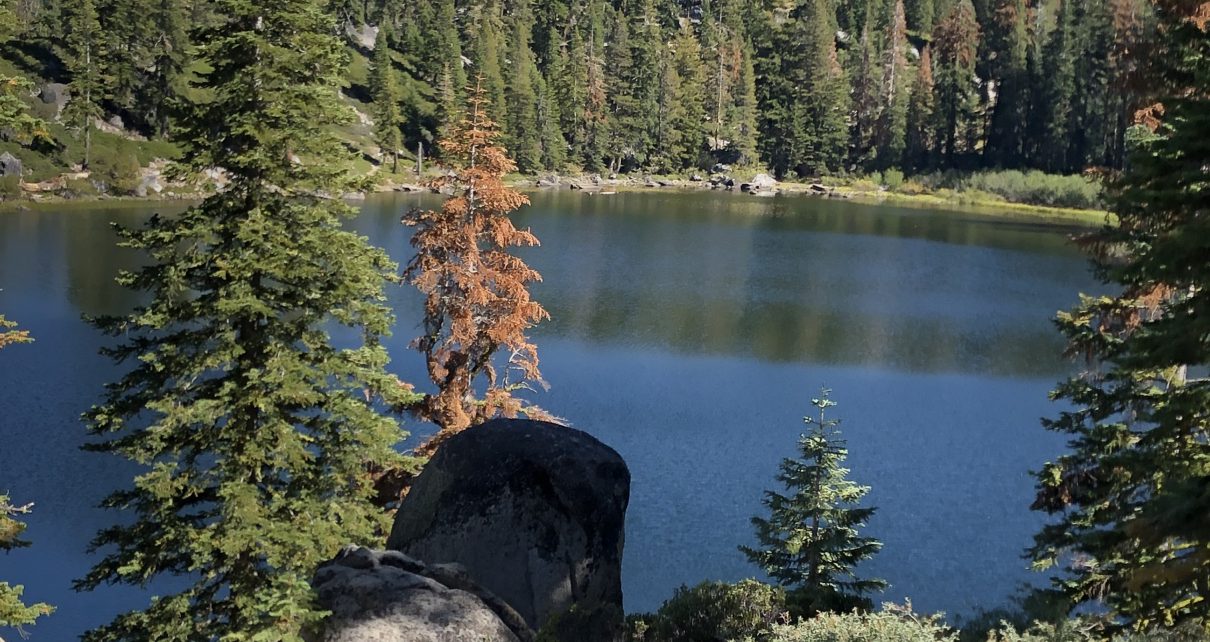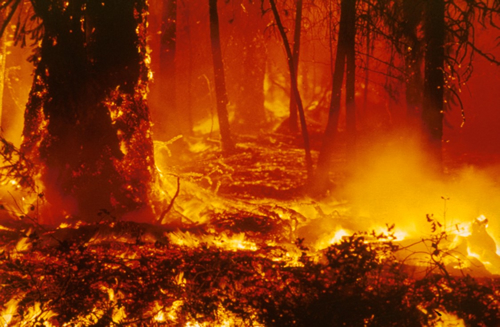
El Dorado National Forest, California. (Photo: Katy Grimes for California Globe)
How to Save California’s Forests
California’s forests endured countless droughts for about twenty million years
By Edward Ring, October 20, 2020 2:13 am
For about twenty million years, California’s forests endured countless droughts, some lasting over a century. Natural fires, started by lightning and very frequent in the Sierras, were essential to keep forest ecosystems healthy. In Yosemite, for example, meadows used to cover most of the valley floor, because while forests constantly encroached, fires would periodically wipe them out, allowing the meadows to return. Across millennia, fire driven successions of this sort played out in cycles throughout California’s ecosystems.
Also for the last twenty million years or so, climate change has been the norm. To put this century’s warming into some sort of context, Giant Sequoias once grew on the shores of Mono Lake. For at least the past few centuries, forest ecosystems have been marching into higher latitudes because of gradual warming. In the Sierra Foothills, oaks have invaded pine habitat, and pine have in-turn invaded the higher elevation stands of fir. Today, it is mismanagement, not climate change, that is the primary threat to California’s forests. This can be corrected.
In a speech before the U.S. Congress last September, Republican Tom McClintock summarized the series of policy mistakes that are destroying California’s forests. McClintock’s sprawling 4th Congressional District covers 12,800 square miles, and encompasses most of the Northern Sierra Nevada mountain range. His constituency bears the brunt of the misguided green tyranny emanating from Washington DC and Sacramento. Here’s an excerpt from that speech:
“Excess timber comes out of the forest in only two ways – it is either carried out or it burns out. For most of the 20th Century, we carried it out. It’s called ‘logging.’ Every year, US Forest Service foresters would mark off excess timber and then we auctioned it off to lumber companies who paid us to remove it, funding both local communities and the forest service. We auctioned grazing contracts on our grasslands. The result: healthy forests, fewer fires and a thriving economy. But beginning in the 1970’s, we began imposing environmental laws that have made the management of our lands all but impossible. Draconian restrictions on logging, grazing, prescribed burns and herbicide use on public lands have made modern land management endlessly time consuming and ultimately cost prohibitive. A single tree thinning plan typically takes four years and more than 800 pages of analysis. The costs of this process exceed the value of timber – turning land maintenance from a revenue-generating activity to a revenue-consuming one.”
When it comes to carrying out timber, California used to do a pretty good job. In the 1950s the average timber harvest in California was around 6.0 billion board feet per year. The precipitous drop in harvest volume came in the 1990s. The industry started that decade taking out not quite 5.0 billion board feet, and by 2000 the annual harvest had dropped to just over 2.0 billion board feet. Today, only about 1.5 billion board feet per year come out of California’s forests as harvested timber.
Expand the Timber Industry
What Congressman McClintock describes as a working balance up until the 1990s needs to be restored. In order to achieve a sustainable balance between natural growth and timber removals, California’s timber industry needs to triple in size. If federal legislation were to guarantee a long-term right for timber companies to harvest trees on federal land, investment would follow.
Today only 29 sawmills remain in California, along with eight sawmills that are still standing but inactive. In addition, there are 112 sites in California where sawmills once operated. In most cases, these vacant sites of former mills are located in ideal areas to rebuild a mill and resume operations.
The economics of reviving California’s timber industry are compelling. A modern sawmill with a capacity of 100 million board feet per year requires an investment of $100 million. Operating at a profit, it would create 640 full time jobs. Constructing 30 of these sawmills would create roughly 20,000 jobs in direct employment of loggers, haulers and mill workers, along with thousands of additional jobs in the communities where they are located.
The ecological impact of logging again in California’s state and federal forests will not become the catastrophe that environmentalists and regulators once used as the pretext to all but destroy the logging industry. Especially now, with decades of accumulated experience, logging does more good than harm to forest ecosystems. There is evidence to prove this.
In forests managed by Sierra Pacific, for example, owl counts are higher than in California’s federally managed forests. Even clear cutting, because it is done on a 60 to 100 year cycle, does more good than harm to the forests. By converting one or two percent of the forest back into meadow each year, area is opened up where it is easier for owls to hunt prey. Also, during a clear cut, the needles and branches are stripped off the trees and left to rejuvenate the soil. The runoff is managed as well, via contour tilling which follows the topography of the hillsides. Rain percolates into the furrows, which is also where the replacement trees are planted.
While clear cutting will not destroy most ecosystems, since it is only performed on one to two percent of the land in any given year, there are other types of logging that can be used in areas deemed more ecologically sensitive. Southern California Edison owns 20,000 acres of forest around Shaver Lake in Southern California where they practice what is referred to as total ecosystem management.
Earlier this year, when the Creek Fire burned an almost unthinkable 550 square miles in Southern California, the 30 square mile island of SCE managed forest around Shaver Lake was unscathed. This is because for decades, SCE has been engaged in timber operations they define as “uneven age management, single tree selection,” whereby the trees to be harvested are individually designated in advance, in what remains a profitable logging enterprise. Controlled burns are also an essential part of SCE’s total ecosystem management, but these burns are only safe when the areas to be burned are caught up on logging and thinning.
The practice of uneven age management could be utilized in riparian canyons, or in areas where valuable stands of old growth merit preservation. The alternative, a policy of hands-off preservation, has been disastrous. Tree density in the Sierra Nevada is currently around 300 per acre, whereas historically, a healthy forest would only have had around 60 trees per acre. Clearly this number varies depending on forest type, altitude and other factors, but overall, California’s forests, especially on federal lands, contain about five times the normal tree density. The result are trees that cannot compete for adequate moisture and nutrients, far less rain percolating into springs and aquifers, disease and infestation of the weakened trees, and fire.
This alternative – manage the forest or suffer fires that destroy the forest entirely – cannot be emphasized enough. In the Feather River Canyon, along with many other canyons along the Sierra Nevada, the east-west topography turned them into wind tunnels that drove fires rapidly up and down the watershed. Yet these riparian areas have been among the most fiercely defended against any logging, which made those fires all the worse. The choice going forward should not be difficult. Logging and forest thinning cannot possibly harm a watershed as much as parched forests burning down to the soil, wiping out everything.
Expand the Biomass Power Industry
If removing trees with timber operations is essential to return California’s forests to a sustainable, lower density of trees per acre, mechanical removal of shrub and undergrowth is an essential corollary, especially in areas that are not clear cut. Fortunately, California has already developed the infrastructure to do this. In fact, California’s biomass industry used to be bigger than it is today, and can be quickly expanded.
Today there are 22 active biomass power plants in California, generating just over a half-gigawatt of continuous electric power. That’s one percent of California’s electricity draw at peak demand; not a lot, but enough to matter. Mostly built in the 1980s and ’90s, at peak there were 60 biomass power plants in California, but with the advent of cheaper natural gas and cheaper solar power, most of them were shut down. These clean burning plants should be opened back up to use forest trimmings, as well as agricultural waste and urban waste as fuel.
At a fully amortized wholesale cost estimated somewhere between 12 cents and 14 cents per kilowatt-hour, biomass power plants cannot compete with most other forms of energy. But this price is not so far out of reach that it could not be subsidized using funds currently being allocated to other forms of renewables infrastructure or climate change mitigation. Moreover, this kilowatt-hour price necessarily includes the labor intensive task of going into the forests and extracting the biomass, creating thousands of good paying jobs. The numbers could work.
If, for example, biomass power capacity in California were roughly doubled to 1.0 gigawatt of continuous output, a six cents per kilowatt-hour subsidy would cost about $500 million per year. This must be compared to the annual cost of wildfires in California, which easily exceeds a billion per year. It also must be compared to the amount of money being thrown around on projects far less urgent than rescuing California’s forest ecosystems, such as the California High Speed Rail project, which has already consumed billions. And if this entire subsidy of $500M per year were spread into the utility bills of all Californians, it would only amount to about a 1.5 percent increase.
Will Politicians Do the Right Thing?
The logic of these steps seems impeccable. Thin the forests. Restore them to ecological health. Adopt time tested modern logging practices and revive the timber industry. Build biomass power plants on the perimeter of the forests. Reissue grazing permits for additional cost-effective brush thinning. Prevent ridiculous, costly, horrific, tragic wildfires. Help the economy.
But these steps have been known for decades, and nothing was done. Every time policymakers were close to a consensus on forest thinning, government bureaucrats obstructed the process and the environmentalists sued to stop the process. And they won. Time and time again. And now we have this: millions of acres of scorched earth, air so foul that people couldn’t leave their homes for weeks, and wildlife habitat that in some cases will never recover. If this failure in policy doesn’t leave Californians livid, nothing will.
The forest management policies adopted in California have decimated California’s timber industry, neglected its biomass industry, turned millions of acres of forest into scorched earth, and are systematically turning mountain communities into ghost towns. This is tyranny, and perhaps even worse, it is tyranny that lacks either benevolence or wisdom.
If the goal was to have a healthy forest ecosystem, that was violated, as these forests burned to the ground and what remains is dying. If the goal was do anything in the name of fighting climate change and its impact on the forests, and do it with urgency, that too was violated, because everything they did was wrong. Even now, instead of urgent and far reaching changes to forest management policies, we get more electric car mandates. That was the urgent response.
California’s ruling elites, starting with Gavin Newsom among the politicians, and Ramon Cruz, the Sierra Club’s new president, may prove they care about the environment by sitting down with representatives from California’s timber, biomass energy, and cattle industries, along with federal regulators, and come up with a plan. They might apply to this plan the same scope and urgency with which they so cavalierly transform our entire energy and transportation industries, but perhaps with more immediate practical benefits both to people and ecosystems.
- Ringside: Will the Delta Pumps Operate at Capacity this Winter? - December 18, 2025
- Ringside: Will Advocates for More Water Supply Projects Find Unity? - December 11, 2025
- Ringside: EVs and California’s Future Demand for Electricity - December 4, 2025





Thank you, Mr. Ring, for your tireless efforts to expose the lies, crimes and corruption of California Democratic leaders, public employee unions, and environmental ambulance chasers that are ravaging taxpayers and citizens the way fires have ravaged our forests.
You’ve said it so well, Keith Cook. Wholeheartedly agree. Grateful for Edward Ring’s talent and insight — and optimism — with regard to our public policies and how they affect real Californians.
Excellent, excellent article Mr. Ring. But getting the Governor and radicals like the Sierra Club to come to their senses is something that I don’t see happening. With them it’s “my way or the highway”.
I don’t think anyone will build a mill under the current regime as they know the rug will be pulled out from under them whenever Democrats feel like it. Political stability and a roll back of anti-logging laws will be required for logging to resume.
Biomass is a losing proposition for loggers and landowners, the only way it makes financial sense is to burn waste from a lumber mill.
From the capitalistic viewpoint, your answer is logging. As a former timber sale administrator, I can tell you that taking out green trees does nothing to solve the fire problem in our forest. The reason the problem persists is because the materials that carry fire in our forests do not have commercial value. We have to pay to have them removed and that has been the problem all along. Biomass has come closest to being a commercial Enterprise but as noted in the article, requires subsidies. Going back to the bad old days is also not the answer. The project you mentioned that worked well is a result of what we have learned from the past and are moving forward with a holistic approach. A paradigm change is what may help. If you want to look in the distant past, one of the original instructions given to humans was to give back to the Earth what you take. How does that fit into your answer? Logging and grazing are both extractive industries that take from the land and give nothing back. Maybe Mother Nature is going about the healing with or without us.
Logging done properly does reduce fire danger and improves the forest health as you should know. Grossly overcrowded trees increases the fire danger and the spread of disease which in turn kills trees and the remaining trees are often times malformed and unhealthy. Brushing and thinning are simply part of good logging practices. Grazing and logging are renewable resources which when done properly provide wood and beef at no cost to the environment.
The article was very good I do appreciate fact that people are noticing how nature is taking its own strides to survive, like the trees elevating to a more safer altitude to endure apparent change.
Climate change is not a new occurrence, I heard about it back in the 70s from my High School science teacher before it was called Climate Change it was known as Hemispheric transfer. I, being from the Midwest, had to deal with drastic seasonal adjustments.
From the frostbite in the winter that would destroy a whole harvest in a matter of days,to seasonal flooding when the snow melts in the spring saturating the soil on a whole hillside causing the dirt to lose it’s cohesiveness and slide hundreds of feet covering homes, railroad tracks, and even wildlife..
Those were the early days of the 40s until the late 70s, but in every situation we have invented a way to remedy every one of these natural situations. Right now, we are working on a system that will not only prevent Wild Fires and Erosion, but have an automatic Ilirrigation system within a ground cover that was extinguished even rolling wide Fire. Plants that are indigenous to the area to prevent fires like what happened in Paradise California in other places. Where millions of acres of terrain in all sorts of topography have been dry, primarily because of drought from previous fires have scorched the land. Nature’s natural cycle have replenisih the land and we have been able to have watered areas where there was no water. We’ve been able to supply hundreds thousands of gallons of fresh water consistently irrigating areas when there is not a reservoir Ocean or lake for hundreds of miles away. All the county locality city of state has to do ECE rate the ground keep it vibrant and safe and disease-free.
The people that I hear are resourceful diligent and more than able make Feats like this to be more than just imaginable but possible